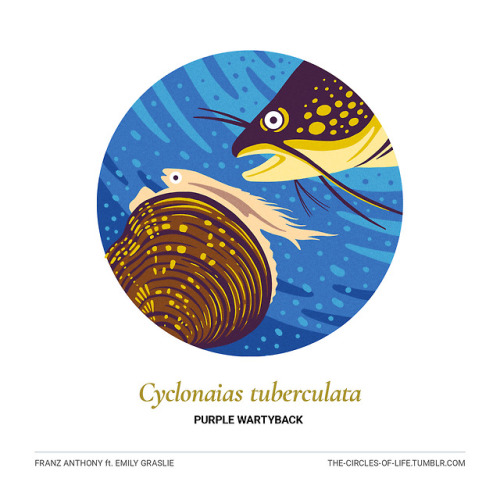#istandwithunionidbivalves
Cyclonaias tuberculata
Purple Wartybackft. Emily Graslie / @thebrainscoop
It all began during a happy hour chat between staffs of the Field Museum, Chicago. Emily Graslie, Chief Curiosity Correspondent, was talking with her colleague, Dr. Janet Voight, about how ‘easy’ it is for endangered animals like tigers and pandas to find support while many others are rarely talked about.
The subject of their conversation, the mussels of the scientific family Unionidae, fall into this group. Among them is the Purple Wartyback.
It was the first name of a mussel she learned and she thought, “Jesus, we’re not doing these animals any favors by giving them names like WARTYBACK.”
Unsavory name aside, they are masters of trickery. A part of their soft body, the mantle, mimics a tiny fish. When they’re ready to breed, female mussel waves this part around to attract a larger fish that preys on the real fish the mussel resembles.
Once the fish takes the bait, she shoots her babies into the fish’s mouth. These then latch onto the fish’s gills until they’re big enough to drop off somewhere else in the river and continue growing.
“What blows my mind is that even though it’s not like bivalves have eyes or can see — their mantles have evolved to look AND ACT LIKE the favorite prey species of the fish they are trying to attract. This is just such an amazing, mind-blowing feat of hundreds of millions of years of evolutionary adaptation and success.”
Emily thinks animals like mussels should not only be celebrated for their cool, sexy, lives, but also understood and cared about for their ecological, cultural, and economic values. “I’m committed to helping people redefine what we consider to be charismatic. Charisma is, for better or worse, a currency that seems to pay for advocacy.”
This is what she’s doing through her YouTube channel ‘The Brain Scoop’ where she creates fun, educational videos for an international audience, highlighting the research and collections of natural history museums.
“I know we can’t/won’t reach everyone — but I wish more people felt a shared sense of personal responsibility for being stewards of our planet, wherever they are in the world. Individuals truly do make a difference.”
—
Emily Graslie is the Chief Curiosity Correspondent at the Field Museum. Get to know Emily and her work behind-the-scenes of natural history museums.
Twitter·Tumblr·Instagram· Youtube·Podcast
—
I helped with a thing!
Post link
Just had to share a design I recently finished up! I’ve actually had this design on the backburner for years, but got the drive to come back to finally finish it.
It’s referencing the amazing youtube channel The Brain Scoop and a discussion on conservation efforts being spent towards marketable animals like pandas vs more environmentally necessary animals like unionid bivalves.——-
Please don’t remove the caption or the watermark.
Please don’t repost without permission. Thank you!WAIT
HOLD ON
I NEED THIS. I’M GOING TO MAKE THIS HAPPEN WE ARE GOING TO HAVE THIS SHIRT THANK YOU @annekubis

We made it happen!
Freshwater bivalves are the largest group of threatened/endangered species on the planet. To help raise awareness for these under-appreciated filter-feeders, we have a limited number of shirts and decals – just in time for Endangered Species Day (tomorrow!)
Post link


